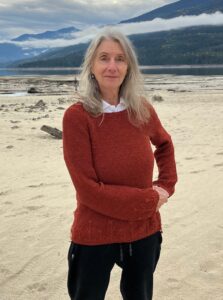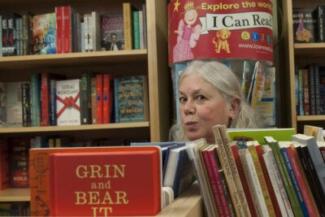One ‘of those undeserving people’?
A Reluctant Mother
by Deirdre Simon Dore
Vancouver: Ronsdale Press, 2024
$25.95 / 9781553807100
Reviewed by Heidi Greco
*

It’s possible that the best place to begin any discussion of Deirdre Simon Dore’s A Reluctant Mother is with her biography.
Among the expected bits about the author’s education (a university degree, a Creative Writing MFA) come a few unusual details: “After homesteading on a remote island in B.C., she moved inland where she acquired a woodlot licence on which she planted trees and learned to use a chainsaw.” In terms of the novel’s details, these life experiences play exceedingly minor roles; of more importance is the fact that Kootenays resident Dore is not just an award-winning writer of fiction, but a playwright with works produced in Vancouver and Calgary
It is from the perspective of her having written plays that I came to a better understanding of A Reluctant Mother. In particular, Dore favours the slow reveal, a stage technique as old as Shakespeare.
Even the book’s opening pages can leave the reader wondering what’s going on: the narrator makes references to a psychiatrist and a lawyer, but also mentions IV lines and the smell of Lysol. Hospital. Okay, but why there, when we’re soon taken to a house just outside the town of Hope?
But it isn’t fair to leave you so in the dark, I am sure. Without giving away too much, suffice it to learn that the main character is an artist named Frida. She’s just come home from having her work pretty much passed over (with only an honourable mention) when she’d hoped for an exhibit in Edmonton. Although her husband Blake tries to comfort her, we learn that he’s not exactly fulfilling his dreams either. He’s an IT guy currently working as a plumber while he tries to establish his computer business. The upstairs is occupied by Frida’s grandmother, Roxanne, along with her caregiver, ‘the Buffalo.’
So there they are: a man and his wife in a small BC town, with a chicken coop that serves as an artist’s studio and, it mostly seems, ravens for company. But when Blake comes home with news that he’s met a fellow named Joel, a gallery owner from Seattle who’s interested in Blake’s style of techie-help, things start looking up. And they look even better when he mentions that this same Joel fellow is looking for an up-and-coming artist to exhibit in his gallery. Blake has gone ahead and invited Joel and his wife to the Halloween party he and Frida are hosting to celebrate their own tenth anniversary.

Frida has dressed up as her namesake, even darkening her eyebrows to further the likeness, and set out platters of what she calls “All the food groups…Brie and prosciutto for the gallerists and hot dogs for the coffee klatchers.” When a knock comes at the door, Frida assumes it’s a trick-or-treater, but it isn’t. There’s a distraught woman at the door asking Frida whether she has a gun. And all of this has happened in only Chapter One. Slow reveal, you may be wondering? Trust me, there’s so much more to come.
This woman at the door turns out to play a major role in the coming action, and the child who arrives along with her an even bigger one. But all of these plot elements take time, with the plot unravelling bumpety-bump—and sometimes so abruptly, you’ll want to shake your head to be sure of what’s just happened.
As for Frida and Blake, it’s important to know that together, they’ve made the decision to not have children:
We retreated to our lair that night and named off every great artist we knew who was childless: Frida Kahlo (yes, her), Georgia O’Keefe [sic], Emily Carr, even Dolly Parton…. Their art was their progeny. Consider my own mother, a famous artist who had shipped me off to Roxanne to raise. Didn’t that prove the point? …. The idea that some people did not deserve children, and maybe that I was one of those undeserving people, was an idea I was loath to investigate. Like a mosquito buzzing about my brain, I swatted it away and convinced myself it was about creativity—and art.
And in truth, art is the enduring theme that binds the many seemingly loose ends in this novel. Sometimes it’s art accomplished; more often, it’s the frustration that grows from not being able to produce it. One time when Joel comes to visit Frida in her coop studio, she freaks out: “My first thought was that he was dropping me as a featured artist…. I had thrown myself feverishly into my art practice for four days now. I had sketches and scribbles and ideas pummelling me from every side, albeit ideas that vanished under scrutiny, still….”
Both the psychiatrist and the lawyer (who Frida comes to call “my little lawyer”) appear and re-appear, often practically out of nowhere, just as some Shakespearean characters have been known to do. The little lawyer produces an infant who regularly does those things that infants do—fart, belch, vomit up milk, and more—possibly reinforcing Frida’s intent to avoid such a fate as motherhood.
But re-appearing characters aren’t the only ‘slow reveal’ methods Dore borrows from Will the Master. Plot twists galore, along with symbols (deer, and oh yes, those ravens); and multiple perspectives abound. It takes nearly to the novel’s end to truly unravel the many up-and-down turns this story takes. Reluctant to be a mother, Frida may well be, but honest (in her own way) she is, right down to the occasional small confession: “There are two kinds of people in the world, morning people and not morning people. Can you guess which kind of people I am?”
This is a book that’s bound to keep you guessing—about more than I have room to mention. But while you’re guessing, I’m betting that you’ll keep turning pages, just as I did, and that, when you get there, you won’t be disappointed in the least.
*

Heidi Greco lives in Surrey, where some would contend she can often still be found to be tilting at windmills. [Editor’s note: Heidi Greco has reviewed an exhibit by Douglas Coupland and books by M.A.C. Farrant, Michael Maitland, David Zieroth, Christine Lowther, Rhona McAdam, Richard Lemm, Souvankham Thammavongsa, Marguerite Pigeon, and John Gould for BCR. Three of her books have also been reviewed here: Glorious Birds: A Celebratory Homage to Harold and Maude (Anvil, 2021), by Linda Rogers; From the Heart of it All: Ten Years of Writing from Vancouver’s Downtown Eastside (Otter Press, 2018), by Yvonne Blomer; and Practical Anxiety (Inanna, 2018), reviewed by Andrew Parkin.]
*
The British Columbia Review
Interim Editors, 2023-25: Trevor Marc Hughes (nonfiction), Brett Josef Grubisic (fiction and poetry)
Publisher: Richard Mackie
Formerly The Ormsby Review, The British Columbia Review is an online book review and journal service for BC writers and readers. The Advisory Board now consists of Jean Barman, Wade Davis, Robin Fisher, Barry Gough, Hugh Johnston, Kathy Mezei, Patricia Roy, Maria Tippett, and Graeme Wynn. Provincial Government Patron (since September 2018): Creative BC. Honorary Patron: Yosef Wosk. Scholarly Patron: SFU Graduate Liberal Studies. The British Columbia Review was founded in 2016 by Richard Mackie and Alan Twigg.
“Only connect.” – E.M. Forster